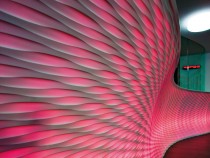
© Nikolay Kazakov
To this day, traditional Japanese sliding partitions made of rice paper have retained their enigmatic charm. In Western cultures, since the beginning of the twentieth century, the quest to maximise transparency – and, with it, the need to provide a screen to the world beyond – has been inextricably liked to the notion of flowing open spaces. In Friedrich Kiesler’s Space House (1933), for example, a curtain running along one of the buildings corners serves as the physical enclosure. And at the Johnson Wax Building (1944), Frank Lloyd Wright had already begung to employ horizontal glass tubes in the partition walls and strip windows. Philip Johnson received international acclaim for his Glass House (1949): the exterior walls were all executed in single panes of glass. But despite the fascination with these designs, in many cases they do not meet today’s safety standards and are susceptible to soiling or damage. In addition, the building physics and assemblies are often problematic. Engineers and materials science experts are in perpetual competition to develop new materials and building components. But an important change has occurred: the strict separation of different types of glass, plastics, metal and even concrete or wood has been abandoned. The classic functional distinction between the part of the window one looks through and the part that keeps the sun out is increasingly being replaced by integrated solutions, or upgraded with additional functions that improve the indoor acoustics, extract electric or thermal energy, or serve as information carrier or media facade. (Frank Kaltenbach, Roland Pawlitschko)


















